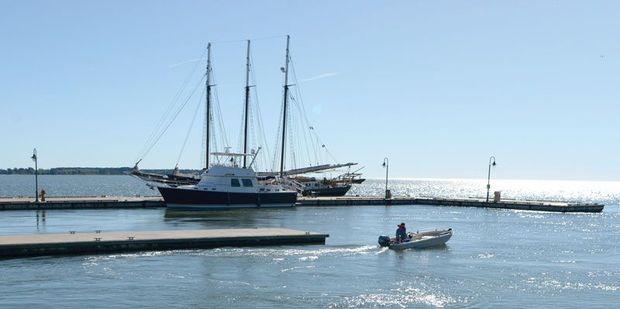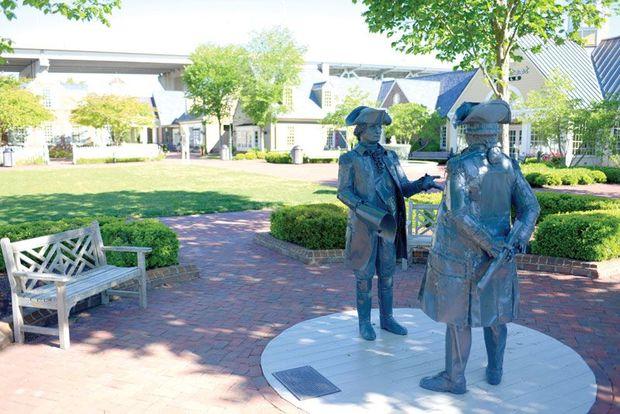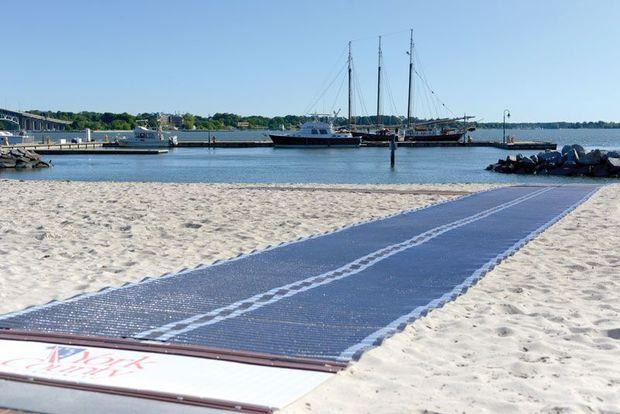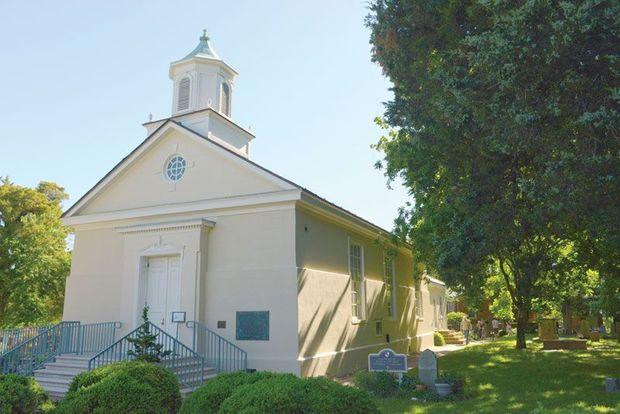Every PropTalk reader knows Yorktown. It’s that small town where the British surrendered to General George Washington. It is the place where the United States of America won independence. But have you been there recently? Do you know what Yorktown is today?

Yorktown was founded in 1691. With high bluffs overlooking deep water close to shore, it was an ideal port. Thomas Jefferson thought Yorktown was the best port in Virginia, ahead of Norfolk. In the 1700s, Yorktown grew into a major export center, and the product was tobacco. Tobacco exports flooded the town with money. The ships that took tobacco to Europe returned with luxurious goods such as silver, clothing, fine furniture, liquor, wine, and firearms. Slaves were also brought to Yorktown. Stately homes were built on the bluff. The peak of this activity took place in the years after 1740. The Nelson family grew to prominence and at one time owned three large homes in town. Thomas Nelson signed the Declaration of Independence.
But the good fortune would not last. While the Revolutionary War was a victory for the United States, it was not a victory for Yorktown. Many homes and buildings were destroyed during the siege. There was a large fire in 1814. Tobacco wore out the soil, so exports of the primary money crop declined.

More damage took place during the Civil War in 1862. The town faded from prosperity. Yorktown’s port was passed by those of Norfolk and Newport News. The town slept until 1931. The upturn came when Uncle Sam bought land in and around the town and formed Colonial National Historical Park. The Colonial Parkway connected historic Yorktown with Williamsburg and Jamestown, and the well-known Historic Triangle was formed.
Today, the town does not look much like it did in 1781, but some of the old buildings remain. There is Grace Episcopal Church, the oldest building in town, dating to 1697. Numerous members of the Nelson family are buried in the cemetery. Other old buildings include the Nelson House, Customhouse, and Moore House, where terms of the British surrender were negotiated. If you use your imagination, you can still see the shopkeepers, merchants, and seamen along the waterfront, called “The Common Shore” in its prime.

On the newer side is Riverwalk Landing, a beautiful combination of shops and restaurants. Before or after eating, you can browse a bookstore, check out various galleries, rent a bicycle, or take a river cruise. The mile-long waterfront trail is perfect for evening strolls. The beach is open to the public. The town just installed a Mobi-mat on the beach; this allows any type of wheeled device to get on to the beach. It is perfect for those with strollers, walkers, or wheelchairs. There is more, such as the actual Yorktown Battlefield, the Watermen’s Museum, the American Revolution Museum, and Cornwallis Cave. You can take an evening ghost tour if you are so inclined.
The town is ideally set up for visiting boaters. There are two public piers, one by Riverwalk and another just up the beach. These cater to day visitors as well as those who want to stay overnight. The concrete piers furnish electrical and water hookups, and pump-out service is provided. And the water is plenty deep, with a minimum depth of 27 feet. Reservations are suggested in the summer, and can be made by calling the dockmaster at (757) 890-3370 or emailing
[email protected].

Dockmaster Rob Parker said “Our office is open from 10 a.m. to 9 p.m. daily after May 30 each year. Small boats can tie up for four hours free Monday through Thursday. After four hours, and Friday through Sunday, it costs $5 per four hours. Overnight rates vary between $1.50 and $2 per foot.” The dockmaster’s office is full of information, and you can even find the latest edition of PropTalk in its rack.
If you want to launch a boat, there is a public ramp just across the bridge at Gloucester Point. A word of caution: the York River is narrow between Yorktown and Gloucester Point. The current literally rips through the area under the bridge. It is not suited for inexperienced paddlers or swimmers.
It does not matter if you are an art lover, boater, foodie, or history buff, as Yorktown is definitely worth a visit for all. For more information, log on to
yorkcounty.gov.
by Kendall Osborne Yorktown was founded in 1691. With high bluffs overlooking deep water close to shore, it was an ideal port. Thomas Jefferson thought Yorktown was the best port in Virginia, ahead of Norfolk. In the 1700s, Yorktown grew into a major export center, and the product was tobacco. Tobacco exports flooded the town with money. The ships that took tobacco to Europe returned with luxurious goods such as silver, clothing, fine furniture, liquor, wine, and firearms. Slaves were also brought to Yorktown. Stately homes were built on the bluff. The peak of this activity took place in the years after 1740. The Nelson family grew to prominence and at one time owned three large homes in town. Thomas Nelson signed the Declaration of Independence.
But the good fortune would not last. While the Revolutionary War was a victory for the United States, it was not a victory for Yorktown. Many homes and buildings were destroyed during the siege. There was a large fire in 1814. Tobacco wore out the soil, so exports of the primary money crop declined.
Yorktown was founded in 1691. With high bluffs overlooking deep water close to shore, it was an ideal port. Thomas Jefferson thought Yorktown was the best port in Virginia, ahead of Norfolk. In the 1700s, Yorktown grew into a major export center, and the product was tobacco. Tobacco exports flooded the town with money. The ships that took tobacco to Europe returned with luxurious goods such as silver, clothing, fine furniture, liquor, wine, and firearms. Slaves were also brought to Yorktown. Stately homes were built on the bluff. The peak of this activity took place in the years after 1740. The Nelson family grew to prominence and at one time owned three large homes in town. Thomas Nelson signed the Declaration of Independence.
But the good fortune would not last. While the Revolutionary War was a victory for the United States, it was not a victory for Yorktown. Many homes and buildings were destroyed during the siege. There was a large fire in 1814. Tobacco wore out the soil, so exports of the primary money crop declined.
 More damage took place during the Civil War in 1862. The town faded from prosperity. Yorktown’s port was passed by those of Norfolk and Newport News. The town slept until 1931. The upturn came when Uncle Sam bought land in and around the town and formed Colonial National Historical Park. The Colonial Parkway connected historic Yorktown with Williamsburg and Jamestown, and the well-known Historic Triangle was formed.
Today, the town does not look much like it did in 1781, but some of the old buildings remain. There is Grace Episcopal Church, the oldest building in town, dating to 1697. Numerous members of the Nelson family are buried in the cemetery. Other old buildings include the Nelson House, Customhouse, and Moore House, where terms of the British surrender were negotiated. If you use your imagination, you can still see the shopkeepers, merchants, and seamen along the waterfront, called “The Common Shore” in its prime.
More damage took place during the Civil War in 1862. The town faded from prosperity. Yorktown’s port was passed by those of Norfolk and Newport News. The town slept until 1931. The upturn came when Uncle Sam bought land in and around the town and formed Colonial National Historical Park. The Colonial Parkway connected historic Yorktown with Williamsburg and Jamestown, and the well-known Historic Triangle was formed.
Today, the town does not look much like it did in 1781, but some of the old buildings remain. There is Grace Episcopal Church, the oldest building in town, dating to 1697. Numerous members of the Nelson family are buried in the cemetery. Other old buildings include the Nelson House, Customhouse, and Moore House, where terms of the British surrender were negotiated. If you use your imagination, you can still see the shopkeepers, merchants, and seamen along the waterfront, called “The Common Shore” in its prime.
 On the newer side is Riverwalk Landing, a beautiful combination of shops and restaurants. Before or after eating, you can browse a bookstore, check out various galleries, rent a bicycle, or take a river cruise. The mile-long waterfront trail is perfect for evening strolls. The beach is open to the public. The town just installed a Mobi-mat on the beach; this allows any type of wheeled device to get on to the beach. It is perfect for those with strollers, walkers, or wheelchairs. There is more, such as the actual Yorktown Battlefield, the Watermen’s Museum, the American Revolution Museum, and Cornwallis Cave. You can take an evening ghost tour if you are so inclined.
The town is ideally set up for visiting boaters. There are two public piers, one by Riverwalk and another just up the beach. These cater to day visitors as well as those who want to stay overnight. The concrete piers furnish electrical and water hookups, and pump-out service is provided. And the water is plenty deep, with a minimum depth of 27 feet. Reservations are suggested in the summer, and can be made by calling the dockmaster at (757) 890-3370 or emailing [email protected].
On the newer side is Riverwalk Landing, a beautiful combination of shops and restaurants. Before or after eating, you can browse a bookstore, check out various galleries, rent a bicycle, or take a river cruise. The mile-long waterfront trail is perfect for evening strolls. The beach is open to the public. The town just installed a Mobi-mat on the beach; this allows any type of wheeled device to get on to the beach. It is perfect for those with strollers, walkers, or wheelchairs. There is more, such as the actual Yorktown Battlefield, the Watermen’s Museum, the American Revolution Museum, and Cornwallis Cave. You can take an evening ghost tour if you are so inclined.
The town is ideally set up for visiting boaters. There are two public piers, one by Riverwalk and another just up the beach. These cater to day visitors as well as those who want to stay overnight. The concrete piers furnish electrical and water hookups, and pump-out service is provided. And the water is plenty deep, with a minimum depth of 27 feet. Reservations are suggested in the summer, and can be made by calling the dockmaster at (757) 890-3370 or emailing [email protected].
 Dockmaster Rob Parker said “Our office is open from 10 a.m. to 9 p.m. daily after May 30 each year. Small boats can tie up for four hours free Monday through Thursday. After four hours, and Friday through Sunday, it costs $5 per four hours. Overnight rates vary between $1.50 and $2 per foot.” The dockmaster’s office is full of information, and you can even find the latest edition of PropTalk in its rack.
If you want to launch a boat, there is a public ramp just across the bridge at Gloucester Point. A word of caution: the York River is narrow between Yorktown and Gloucester Point. The current literally rips through the area under the bridge. It is not suited for inexperienced paddlers or swimmers.
It does not matter if you are an art lover, boater, foodie, or history buff, as Yorktown is definitely worth a visit for all. For more information, log on to yorkcounty.gov.
by Kendall Osborne
Dockmaster Rob Parker said “Our office is open from 10 a.m. to 9 p.m. daily after May 30 each year. Small boats can tie up for four hours free Monday through Thursday. After four hours, and Friday through Sunday, it costs $5 per four hours. Overnight rates vary between $1.50 and $2 per foot.” The dockmaster’s office is full of information, and you can even find the latest edition of PropTalk in its rack.
If you want to launch a boat, there is a public ramp just across the bridge at Gloucester Point. A word of caution: the York River is narrow between Yorktown and Gloucester Point. The current literally rips through the area under the bridge. It is not suited for inexperienced paddlers or swimmers.
It does not matter if you are an art lover, boater, foodie, or history buff, as Yorktown is definitely worth a visit for all. For more information, log on to yorkcounty.gov.
by Kendall Osborne